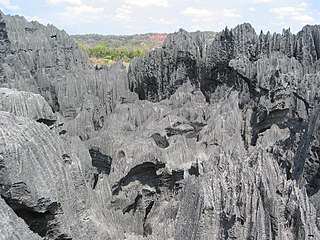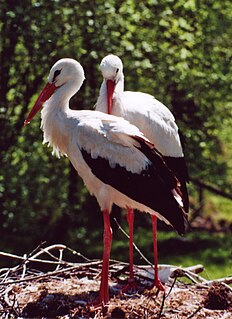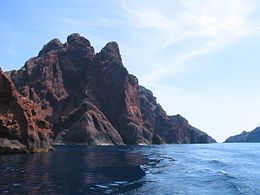
The Ramsar Convention on Wetlands of International Importance Especially as Waterfowl Habitat is an international treaty for the conservation and sustainable use of wetlands. It is also known as the Convention on Wetlands. It is named after the city of Ramsar in Iran, where the convention was signed in 1971.

Ujung Kulon National Park is at the westernmost tip of Java, in Banten province of Indonesia. It includes the volcanic island group of Krakatoa in Lampung province, and other islands including Panaitan, as well as smaller offshore islets such as Handeuleum and Peucang in the Sunda Strait.
Porto-Vecchio is a commune in the French department of Corse-du-Sud, on the island of Corsica.

The Tuscan Archipelago is a chain of islands between the Ligurian Sea and Tyrrhenian Sea, west of Tuscany, Italy.

Panarea is the smallest of the seven inhabited Aeolian Islands, a volcanic island chain in north of Sicily, southern Italy. It is a frazione of the comune of Lipari. There are currently about 280 residents living on the island year-round; however the population increases dramatically in summer with the influx of tourists especially during the months of July and August. In recent years, the island has become known internationally for its celebrity visitors.

The Butrint National Park is a national park in Vlorë County, southern Albania. It is located 18 kilometres (11 mi) south of Sarandë. The park encompasses 9,424 hectares (94.24 km2) of hilly terrain with freshwater lakes, wetlands, salt marshes, open plains, reed beds and islands. The park's significance for conservation is reflected in the large number of species with over 1,200 different animals and plants. Its mandate includes the protection of the lake and lagoon of Butrint, the natural channel of Vivari, the islands of Ksamil and as well the archaeological site, that provides valuable remains of ancient civilisations.

Tsingy de Bemaraha Strict Nature Reserve is a nature reserve located near the western coast of Madagascar in Melaky Region at 18°40′S44°45′E. The area was listed as a UNESCO World Heritage Site in 1990 due to the unique geography, preserved mangrove forests, and wild bird and lemur populations.

Calanques de Piana are Corsican calanques located in Piana, between Ajaccio and Calvi, in the Gulf of Porto. It is part of a UNESCO World Heritage Site that includes other sites in the Gulf of Porto, due to its beauty, rich marine biodiversity, and unique maquis shrubland. The jagged cliffs are made of red ochre.

The Eastern Mediterranean conifer-sclerophyllous-broadleaf forests, also known as the Eastern Mediterranean conifer-broadleaf forests, is an ecoregion in the eastern Mediterranean Basin. It covers portions of Turkey, Syria, Lebanon, Israel, Palestinian territories, Jordan, and Saudi Arabia.
The Regional Natural Park of Corsica is a natural park. It was listed in 1972 and then relisted for 10 years in June 1999. The Natural Park covers nearly 40% of the island of Corsica. A section the park centering on the Gulf of Porto was listed as a UNESCO World Heritage Site in 1983 because of its beauty, excellent representation of Corsican shrubland, and avian and marine diversity.

The wildlife of Libya is spread over the Mediterranean coastline and encompasses large areas of the Saharan desert. The protection of wildlife is provided through appropriate legislation in seven national parks, five reserves, 24 protected areas, two wetlands under Ramsar Convention, and also in other areas. Apart from these, there are also five UNESCO World Heritage Sites related to culture. The most important national parks are the El-Kouf National Park and Karabolli National Park. The well known nature reserves are the Benghazi Reserve and the Zellaf Reserve. The wildlife species recorded in the country are 87 mammals and 338 species of birds.

The Aïr and Ténéré National Nature Reserve is a national nature reserve in Niger. It includes several overlapping reserve designations, and is designated a UNESCO World Heritage Site. It covers both the eastern half of the Aïr Mountains and the western sections of the Ténéré desert. It has been identified by BirdLife International as an Important Bird Area.

The Aïr and Ténéré Addax Sanctuary is a nature reserve in the north center of the nation of Niger. The reserve forms part of the larger Aïr and Ténéré National Nature Reserve, which is a UNESCO World Heritage Site. The Aïr and Ténéré National Nature Reserve covers 77,360 square kilometres (29,870 sq mi), of which 12,800 square kilometres (4,900 sq mi) form the Aïr and Ténéré Addax Sanctuary.

Numinbah Nature Reserve is a protected nature reserve that is located in the Northern Rivers region of New South Wales, in eastern Australia. The reserve was gazetted in December 1981 with a further addition made in 1989 to make the reserve to its current area of 858 hectares. The reserve is situated north-east of the rural locality of Numinbah, and south of the Queensland town of Springbrook and defines part of the state border between New South Wales and Queensland.
Protected areas of Libya include any geographical area protected for a specific use.

El Kouf National Park, established in 1975, is one of the seven national parks of Libya. El Kouf is located along Libya's northeastern Mediterranean coastline and has both marine and terrestrial biodiversity. Libya also has five other reserves, twenty four protected areas and two wetlands, Ain Elshakika Wetland and Ain Elzarga Wetland, protected under the Ramsar Convention since 2000.

The Albanian Ionian Sea Coast is a coastline of the Northeastern Ionian Sea, that encompasses the southwestern border of the Republic of Albania, stretching from the southern half of Karaburun Peninsula, across the historical region of Labëria, the city of Sarandë, the mountains of the Ceraunians and the Albanian Riviera, to the Lake of Butrint, where the Strait of Corfu separates the country from Greece.

The Gulf of Porto is a gulf of the Mediterranean Sea located on the western façade of the island of Corsica, France, well known for its dramatic coloration and rugged cliffs. The gulf is located within the department of Corse-du-Sud. The gulf and surrounding coast is part of the Regional Natural Park of Corsica. In 1983 the gulf was designated as a UNESCO World Heritage Site, encompassing the Calanques de Piana, Gulf of Girolata, and Scandola Nature Reserve, due to its outstanding scenery, rich avian and marine life, and maquis shrubland.

The Fango is a small coastal river in the department of Haute-Corse, Corsica, France. The Fango Valley was designated a biosphere reserve in 1977. It holds flora and fauna representative of all regions of Corsica from the coast to the highest mountains.





















